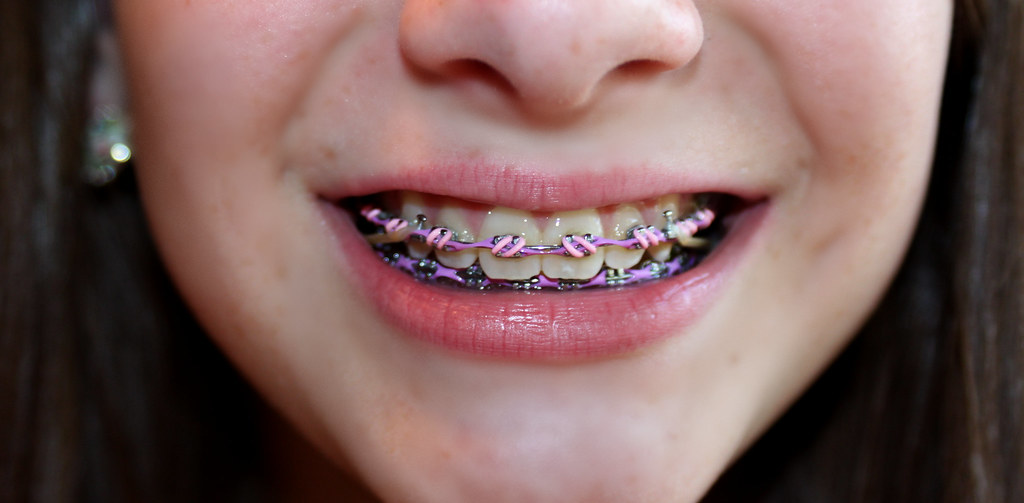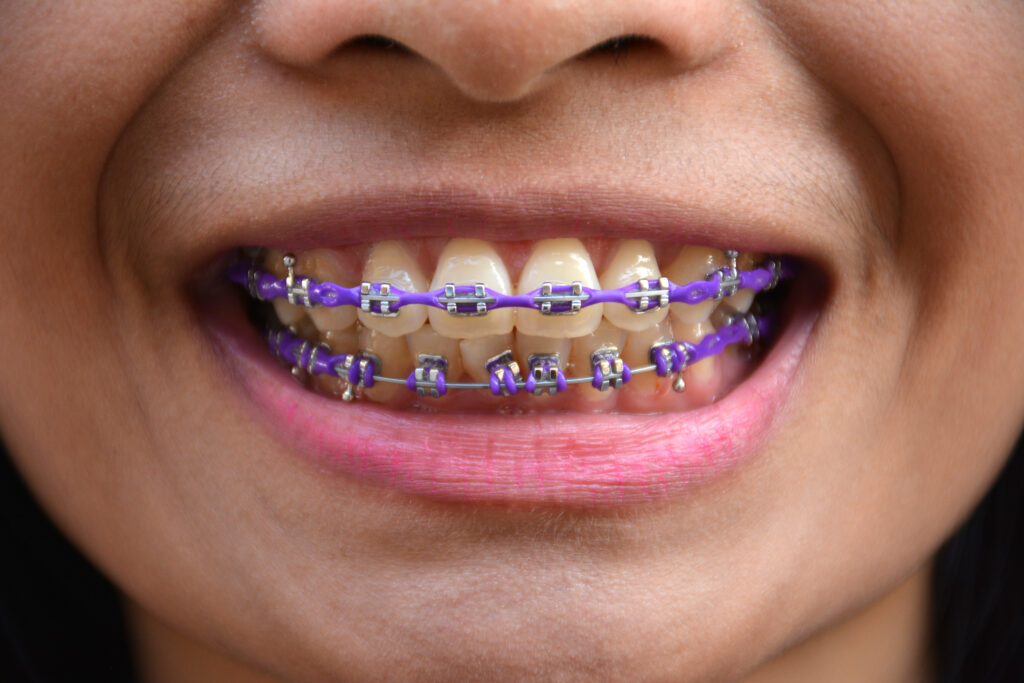If you’re getting braces and want to make a fashionable and flattering statement, one of the top choices for brace colors to consider is purple.
Purple is often viewed as a mystical color that exudes elegance and style. When it comes to selecting the best color for braces, it can be essential to consider various factors such as skin tone, personal preferences, and the impact the color will have on your smile.
Purple braces are versatile and can be an excellent choice for both boys and girls. Darker shades of purple, such as dark blue and dark purple, provide contrast that can make the teeth appear lighter and whiter.
For those with fair skin, cooler shades of light purples could also be a good choice, as they blend well with various skin tones and clothing colors. Moreover, the color purple can match different hair colors and styles, making it a well-rounded option for many individuals seeking to add a touch of personality to their orthodontic journey.
When choosing your braces colors, it’s important to consider the overall visual impact on your smile and how it will affect your self-confidence. Ultimately, the decision to opt for purple braces should rely on your personal preferences and how comfortable you feel with the chosen color.
Remember, your braces are temporary, and you can switch up the colors during your treatment period to find the perfect hue that complements your smile and personality.
Why Color Choices Matter
When it comes to choosing the color of braces, it’s important to consider how different shades will affect the overall appearance of your teeth and smile. The color of braces can have a significant impact on the perception of your teeth’s whiteness, as well as how noticeable the braces themselves are.
Additionally, certain colors can complement an individual’s skin tone or personal style, creating a more cohesive and aesthetically pleasing look.
One popular color choice for braces is purple, as it’s often associated with wealth and royalty, and can be seen as a mystical color. Dark purple, in particular, has been known to make teeth appear whiter due to the contrast it creates. This can be a great option for those who want to maintain a professional appearance or who simply prefer a more subtle look in their braces.
When selecting braces colors, it’s essential to keep in mind that lighter shades such as white may make teeth appear more yellow, while dark colors like black can sometimes be mistaken for food particles stuck in your teeth. Colors like purple or navy blue, on the other hand, tend to create a more appealing contrast with teeth, enhancing their whiteness and overall appearance.
Another aspect to consider while choosing the right color for your braces is coordinating them with your personal style or accessories like lipstick, clothing, or jewelry. This can help create a harmonious and well-thought-out look that increases confidence and self-esteem during the orthodontic treatment process.
Ultimately, taking the time to carefully consider your braces color choices can result in a more satisfying and attractive outcome.

The Color Purple
Purple is a popular choice for braces among many individuals. This section will explore the associations linked with this color and its compatibility with different skin tones.
Color Associations
Traditionally, purple has been associated with royalty, wealth, and a sense of mysticism. This makes it an appealing option for those who want their braces to convey a sense of sophistication or mystery. Moreover, purple braces can be seen as a fun and unique choice, setting them apart from more typical brace colors.
Darker shades of purple, such as dark purple or navy blue, have been suggested to make teeth appear whiter, which can be an advantageous aspect when considering how your braces will affect your smile’s appearance.
Compatibility with Skin Tones
Purple braces can work well with a variety of skin tones. For individuals with fairer skin, darker shades of purple, as well as cooler shades of light blues, pinks, or reds, can complement their complexion nicely. For those with medium or darker skin tones, lighter and more vibrant shades of purple can provide an attractive contrast and enhance their overall appearance.
When selecting purple as a braces color, it’s crucial to consider not only your skin tone but also other aspects, such as your wardrobe, accessories, or makeup preferences. By doing so, you can ensure that your chosen shade of purple works cohesively with your overall personal style.

Deciding on the Best Color for Your Braces
Choosing the right color for your braces can be a personal decision, taking into account factors such as personal style and orthodontist recommendations. This section will cover some of the considerations that can help you find the best color, including purple, for your braces.
Considering Personal Style
One reason to consider using purple for your braces is that it can work well with various skin tones and eye colors. Shades of purple can complement brown or green eyes, while darker purples can contrast with lighter skin and teeth, making them appear whiter.
Another aspect to consider is coordinating the color of your braces with your clothing or favorite accessories. If purple is a color you frequently incorporate into your wardrobe, it might be a natural choice for your braces. Remember that you’ll want to choose a color that you’ll feel comfortable wearing for an extended time.
Consulting with Your Orthodontist
Before making a decision on brace colors, consult with your orthodontist. They may have recommendations based on your specific needs and preferences. Orthodontists typically provide a range of color options, including various shades of purple, so speaking with your orthodontist may help you determine which shade of purple would work best for you.
Orthodontists can also advise on whether certain colors might not be suitable for you or if they can easily stain, which could detract from the appearance of your teeth. Furthermore, they can help you understand the process of changing the colors of the braces bands during your treatment, allowing for more flexibility in your choices.
Alternatives to Colored Braces
While purple braces can be an appealing choice for individuals looking to make a fashion statement, there are other options available for those who prefer a more discreet or refined look. In this section, we will consider some alternatives to colored braces that may be better suited to specific preferences or needs.
Invisalign is a popular alternative to braces with colored bands. This orthodontic treatment uses clear aligners, or trays, to gradually shift the teeth into their desired positions. The primary advantage of Invisalign is its near-invisibility, allowing patients to straighten their teeth without drawing attention to their orthodontic treatment. Invisalign aligners can usually be removed for eating, drinking, and brushing, which is another convenient feature.
Ceramic braces are another option for those who prefer a more discreet appearance. These braces are similar to traditional metal braces but have clear or tooth-colored brackets, making them less noticeable. While they can still have colored bands, individuals can choose lighter shades, which blend easily with the natural color of the teeth.
Lingual braces are custom-made braces attached to the backside of the teeth, making them practically invisible. Unlike Invisalign, lingual braces work similarly to traditional braces but are hidden from view, providing a more inconspicuous option for patients who don’t wish to show any visible signs of orthodontic treatment.
When selecting the best orthodontic treatment for their needs and preferences, patients should consult with their orthodontist to determine which option is most suitable. Factors such as treatment goals, duration, and budget may influence the decision-making process.
Conclusion
In conclusion, purple is considered a good color choice for braces as it offers both aesthetic and practical benefits. It can complement various skin tones, especially fairer ones, and can also work well with other colors such as pink and blue.
Purple is often associated with wealth, royalty, and mystery, making it an attractive and popular option for those looking to make a stylish statement with their braces. Furthermore, its contrasting tone can help make teeth appear whiter and brighter, contributing to a more visually appealing smile.
Ultimately, the best color for braces depends on the individual’s preferences and personal style. Considering factors such as skin tone, favorite colors, and even seasonal occasions can help in making an informed decision. While purple is a good choice for many, it is essential to choose a color that makes the wearer feel comfortable and confident while wearing braces.

